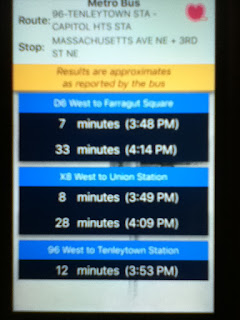I've made my first breakthrough as a (temporary) Washingtonian: I've learned to stop worrying and love the bus system.
I first met the Metro during my first visit to the city 34 years ago. It was a gleaming new transportation system then; now, it is showing the effects of age and possibly deferred maintenance. There've been a few widely-publicized incidents, such as a piece of ceiling falling at the Rhode Island Avenue station, which will be closed for maintenance this summer after the All-Star Game. This week one north-south track was closed for emergency maintenance, creating delays on the green and yellow lines.
I've encountered nothing harrowing on the Metro yet. I enjoy the advantages of trains: the network is simple and gets you around the city fairly quickly without having to deal with auto traffic. Washington's train network has six lines, named after colors, but they share routes so there really are three routes through the city: east-west (blue/orange/silver), north-south (green/yellow), and the red line, which follows a U-shaped route through the northern half of the city. We live half a mile from both Union Station (red) and Eastern Market (blue/orange/silver), so the trains are easy to get to. I prefer Eastern Market, because Columbus Circle by Union Station is difficult for pedestrians to navigate.
Once inside the station, you choose which train to take by the name of the station at the end of the line in the direction in which you're going. This takes practice; I can do it automatically in Chicago but am still learning Washington. Then just find your spot on the track and wait for a train to come. Electronic message boards tell you how long your wait will be, and in the meantime there's WiFi.
The bus system is by comparison a tangle of complexity. Washington, like most cities larger than Cedar Rapids, has many bus routes, so unless you take the same bus to the same place every day this can be mind-boggling. When Jane and I took a bus downtown a couple weeks ago, I think it was the first time I've ever taken a city bus in Washington. The advantages are stops are even closer, and you can see the city go by outside the window.
The key to making the bus system intelligible is the wealth of information available online. My phone's map function includes transit-based directions with the numbers. The DC Metro Transit ap allows me to see, updated in real time, when the next bus will arrive.

Now I use either bus or train, depending on convenience, speed and sometimes weather. I've trained to 1 Million Cups in McLean, Virginia--which ride set me back $5.75 due to congestion pricing. (The hordes of auto drivers who daily flood Tyson's Corners paid nothing extra.) I've bused downtown to a play at Ford's Theater. To get to American University I train downtown and then bus from there. (While bus-to-bus and train-to-train transfers are free, bus-to-train transfers get you 25 cents off.) Washingtonians make a relatively high percentage of daily trips by public transit. In spite of that, or perhaps because of that, driving times--at least as reported by my phone ap--are often shorter than transit times. I'd still rather ride, for a lot of reasons.
 |
| DC Streetcar at the Union Station stop (2nd and H Sts NE), which is sort of near Union Station |
Then there's the mysterious streetcar. Washington has a single streetcar line, which runs east-west along H Street NE for about 2.5 miles. Signs promise that this is merely the first line of a city-wide system "from beyond the Anacostia to the Georgetown waterfront." When I gave it a spin, it seemed serviceable if you happened to have some cause to be going its direction, and the cars were well-occupied both ways. Rides are free, at least "currently" according to another helpful sign. The tram moves on tracks in the street, along with the auto and bus traffic. We were stuck for awhile at one point because a guy in a parked car had his driver's side door open, blocking the track. H Street is a study in the gentrification process, particularly along the western half of the route, where toney restaurants exist next door to pawn shops, and head shops attract serious stoners who co-exist with grocery shoppers at Whole Foods and Giant. (See also Lurie 2016.)
SEE ALSO:
Laura Bliss, "How Seattle is Winning the War on the Car Commute," CityLab, 16 February 2018
Arian Horbovetz, "Transit Moves People, Not Money," Strong Towns, 14 February 2018
Jon Whitely, "Seattle and Honolulu Move Up the Ranks of the Best Cities for Public Transit in 2018," Redfin, 21 February 2018










No comments:
Post a Comment